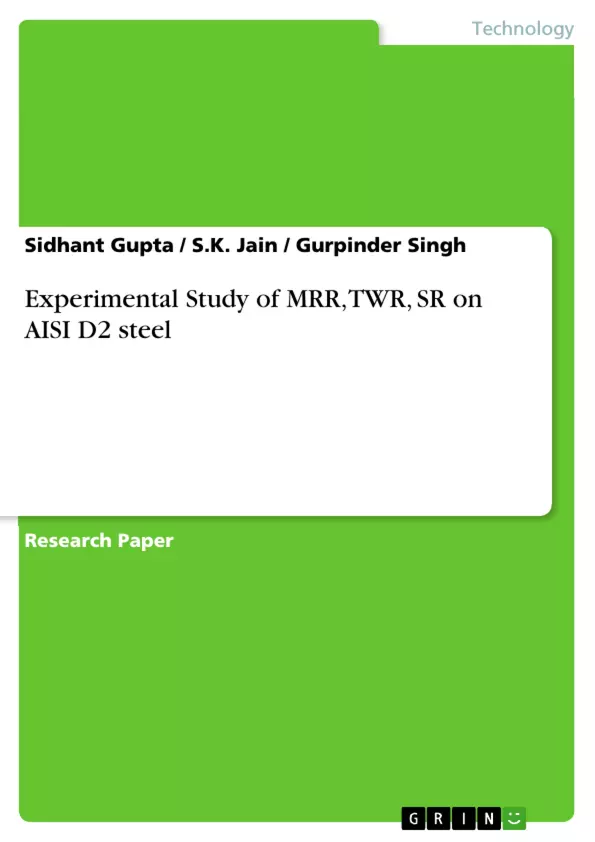This paper depicts the experimental study the input parameters of EDM i.e. current, pulse on time and pulse off time on output parameters material removal rate (MRR), tool wear rate (TWR) and surface roughness (SR). The workpiece materials selected was AISI D2. The aluminium used as tool electrode and EDM oil as dielectric fluid. Taguchi, method was used to perform experiments, L9 orthogonal array was applied using MINITAB software. Signal to Noise (S/N) ratio and ANOVA were employed for parameter optimization and to achieve max MRR, min SR and TWR. The results indicate that the most prompting factor for MRR is Pulse off time. For TWR, the most influencing factor is current. For SR, the most prompting factor is pulse on time. Optimization is done by using Taguchi method on MINITAB 17 software.
Inhaltsverzeichnis (Table of Contents)
- Introduction
- Workpiece and Electrode Material
- Chemical composition of AISI D2 steel
- Evaluation of parameters
- Evaluation of MRR
- Evaluation of TWR
- Signal to noise (S/N) ratio
- Design of Experiments
- Parameter Selected and their levels
- Observation Table
- Results and Discussions
- Conclusion
Zielsetzung und Themenschwerpunkte (Objectives and Key Themes)
This paper investigates the impact of EDM input parameters (current, pulse on time, and pulse off time) on output parameters such as material removal rate (MRR), tool wear rate (TWR), and surface roughness (SR) when machining AISI D2 steel using an aluminium electrode.
- Investigate the influence of EDM parameters on MRR, TWR, and SR.
- Optimize EDM parameters to achieve maximum MRR, minimum SR, and minimum TWR.
- Apply Taguchi method and ANOVA to analyze experimental results.
- Determine the most significant factor influencing each output parameter.
- Identify the optimal EDM settings for machining AISI D2 steel with an aluminium electrode.
Zusammenfassung der Kapitel (Chapter Summaries)
The paper begins with an introduction to EDM as a non-traditional machining process and its applications. It discusses the advantages of EDM for machining difficult materials and highlights the development of modern EDM techniques. The paper then details the workpiece and electrode materials used in the study, AISI D2 steel and aluminium, respectively. The next section focuses on the evaluation of the output parameters, including MRR, TWR, and SR, and their calculation methods. The design of experiments section outlines the use of the Taguchi method and L9 orthogonal array to optimize the EDM parameters. The paper presents the results of the experiments, including tables and graphs, and discusses the main effects of the parameters on MRR, TWR, and SR. The paper concludes by summarizing the findings and providing recommendations for optimal EDM settings for machining AISI D2 steel with an aluminium electrode.
Schlüsselwörter (Keywords)
Electric Discharge Machine, Aluminium Electrode, AISI D2 steel, MRR, TWR, SR, Taguchi method, ANOVA, Optimization, MINITAB.
- Citation du texte
- Sidhant Gupta (Auteur), S.K. Jain (Auteur), Gurpinder Singh (Auteur), 2016, Experimental Study of MRR, TWR, SR on AISI D2 steel, Munich, GRIN Verlag, https://www.grin.com/document/340653



